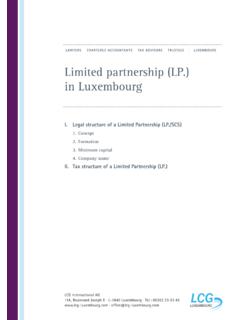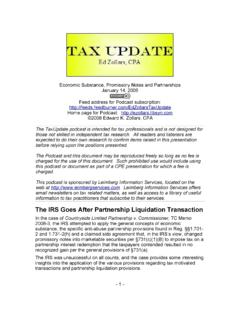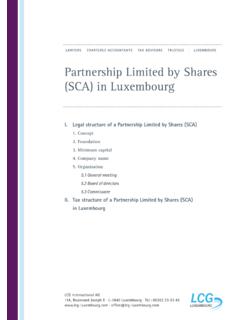Transcription of Partnership Relationship Management White Paper
1 White Paper Partnership Relationship Management Implementing a Plan for Success By Stephen M. Dent 2006 Partnership Continuum, Inc. All Rights Reserved. Partnership Relationship Management : Implementing a Plan for Success 1 Executive Summary Organizations are struggling to react quickly to ever changing customer expectations and needs while struggling with shifting market needs and financial swings. Striving to outmaneuver competitors these days involves capitalizing on highly effective internal and external relationships that ensure the business has the capabilities to support its mission and evolving growth initiatives.
2 The strategy of connectivity to other people and entities is now crucial for innovation and overall success. Businesses today must propagate connections that provide resources they don't possess in house and enable them to move quickly to profit. Conducting business in the twenty first century, therefore, requires forming partnerships and strategic alliances both internally and externally. Creating a partnering culture in your organization will foster collaboration among existing subcultures. Creating a partnering culture positions an organization to accrue four chief benefits: Openness Creativity Agility Resiliency These chief benefits enable business transformation and thus impact the bottom line.
3 Smart partners win not only because of what they do but, even more importantly, from how they do it. They win from leveraging their connectedness and from valuing the building of Relationship skills. The ability to Alliances and partnerships produce astonishing results but only when recognize information flows freely, people trust each other, and are loyal to each other strengths and and their mutual success. Operating from such a vibrant collaborative mind acknowledge set that forgets about getting the bigger slice of the pie requires weaknesses is a interdependence that does not come naturally to any organization.
4 Cultural issue. The energies a culture drives This Paper discusses the characteristics of effective Partnership relationships from the people and presents an outline for implementing a plan for success. It also provides who live and a Relational Survey to help determine a Partnership 's state of health and work within the provides a Partner Relationship Management Assessment, both as tools for Relationship determining an organization's starting point in Relationship Management . structure will foretell success or failure. 2006 Partnership Continuum, Inc. All Rights Reserved. Partnership Relationship Management : Implementing a Plan for Success 2 Characteristics of Effective Partnerships A Partnership is where two or more people need to work together to accomplish a goal while building trust and a mutually beneficial Relationship .
5 This means the Partnership is voluntarily agreed upon, built on the desire to have trust, and based on agreed upon mutual benefits. Effective Typical partnerships have the following characteristics: Partnerships: (1) Partnerships are entered into voluntarily Strategic alliances Partnerships cannot be forced. However, we often find ourselves in situations where we are assigned to partners for example, when we are Joint marketing appointed to a project or task force, join an existing board of directors, work partnerships on a committee at a school, or volunteer to help plan the church picnic.
6 In Union . these cases, relationships can become true partnerships only when all Management involved have defined the goal or task, have identified the mutual benefits, relationships and are committed to building trust. Mergers and acquisitions (2) Partners perceive themselves to be equal in power and accountability In a Partnership , authority and title are meaningless in the delegation of Board of tasks, decision making, and conflict resolution. The only factors that might directors make one partner's perspective take precedence over another's are greater Organizational knowledge or more experience.
7 How roles and responsibilities are assigned executive depends on the demands of the situation and the particular competencies of leadership the partners. teams Organizational (3) Partners have equal access to, and openly share, information and cross functional knowledge / departmental In a Partnership , the emphasis is always on the task or outcome for which partnerships the partners came together in the first place. To that end, all partners need to Public private have access to the same information. partnerships In corporate settings, individuals often operate according to the adage that Non profit / knowledge is power, and they increase their power by hoarding for profit partnerships information parceling out bits and pieces as needed.
8 In a Partnership , however, partners are not focused on power. All partners are perceived as Community . equal and therefore willingly share information. This not only enhances the based functioning of the Partnership but also increases the quality of the outcome. partnerships Synergy and creativity result when people build upon one another's Internal teams information and ideas and departments (4) All partners are perceived as equally valuable, albeit in different ways Partnerships come together when individuals require the contribution of others to accomplish a task or reach a goal.
9 By definition, every partner has something of value to bring to the Partnership , and that something is essential to the quality of the outcome. 2006 Partnership Continuum, Inc. All Rights Reserved. Partnership Relationship Management : Implementing a Plan for Success 3 Therefore, every partner is acknowledged for the value of his or her contribution, and no one partner is viewed as more important than any other. (5) Partners look for opportunities to discover they are wrong When all partners are committed to the excellence of the outcome, they want to continually check that their perceptions, decisions, and actions will produce the best product or service.
10 To that end, they welcome suggestions about how to do things differently and actively seek them out. Partners don't want to be right or have the last word. They want to arrive at the best possible outcome or solution and are open to any and all information that will help them achieve it. (6) Partners seek out and support success for others Partners bring to a Relationship an outlook of abundance. An individual with an abundant outlook believes that there is enough of everything available in the world for everyone to get what he or she needs. People who possess an abundant outlook can seek opportunities for others to succeed and can celebrate others' successes because they know this does not detract from their opportunities to be successful as well.










